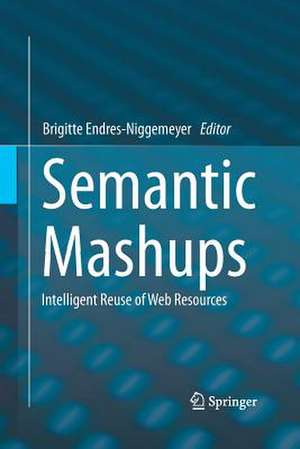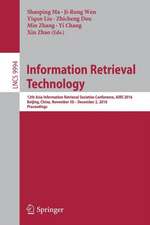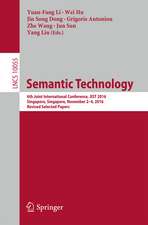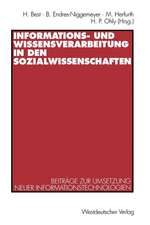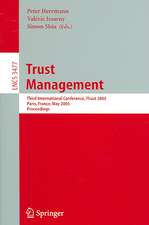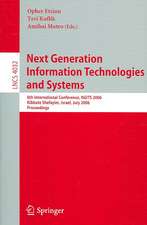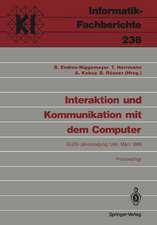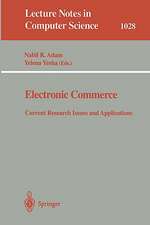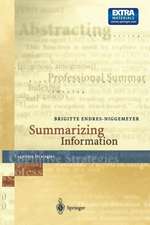Semantic Mashups: Intelligent Reuse of Web Resources
Editat de Brigitte Endres-Niggemeyeren Limba Engleză Paperback – 21 mai 2015
Mashups may contain and mix client-side and server-side activity. Obviously, understanding the incoming resources (services, statistical figures, text, videos, etc.) is a precondition for optimally combining them, so that there is always some undercover semantics being used. By using semantic annotations, neutral mashups permute into the branded type of semantic mashups. Further and deeper semantic processing such as reasoning is the next step.
The chapters of this book reflect the diversity of real-life semantic mashups. Two overview chapters take the reader to the environments where mashups are at home and review the regulations (standards, guidelines etc.) mashups are based on and confronted with. Chapters focusing on DBpedia, search engines and the Web of Things inspect the main Web surroundings of mashups. While mashups upgrading search queries may be nearer to the everyday experience of readers, mashups using DBpedia input and sensor data from the real world lead to important new and therefore less known developments. Finally, the diversity of mashups is tracked through a few application areas: mathematical knowledge, speech, crisis and disaster management, recommendations (for games), inner-city information, and tourism.
Participants of the AI Mashup Challenge wroteall the chapters of this book. The authors were writing for their current and future colleagues – researchers and developers all over the Web who integrate mashup functionalities into their thinking and possibly into their applications.
| Toate formatele și edițiile | Preț | Express |
|---|---|---|
| Paperback (1) | 365.65 lei 6-8 săpt. | |
| Springer Berlin, Heidelberg – 21 mai 2015 | 365.65 lei 6-8 săpt. | |
| Hardback (1) | 341.95 lei 6-8 săpt. | |
| Springer Berlin, Heidelberg – 16 apr 2013 | 341.95 lei 6-8 săpt. |
Preț: 365.65 lei
Preț vechi: 457.07 lei
-20% Nou
Puncte Express: 548
Preț estimativ în valută:
69.98€ • 72.79$ • 57.77£
69.98€ • 72.79$ • 57.77£
Carte tipărită la comandă
Livrare economică 14-28 aprilie
Preluare comenzi: 021 569.72.76
Specificații
ISBN-13: 9783642447136
ISBN-10: 3642447139
Pagini: 392
Ilustrații: VII, 382 p.
Dimensiuni: 155 x 235 x 21 mm
Greutate: 0.55 kg
Ediția:2013
Editura: Springer Berlin, Heidelberg
Colecția Springer
Locul publicării:Berlin, Heidelberg, Germany
ISBN-10: 3642447139
Pagini: 392
Ilustrații: VII, 382 p.
Dimensiuni: 155 x 235 x 21 mm
Greutate: 0.55 kg
Ediția:2013
Editura: Springer Berlin, Heidelberg
Colecția Springer
Locul publicării:Berlin, Heidelberg, Germany
Cuprins
The Mashup Ecosystem.- Mashups live on Standards.- Mashups for web search engines.- DBpedia Mashups.- Mashups for the Web of Things.- Mashups using Mathematical Knowledge.- Speech Mashups.- Mashups for the Emergency Management Domain.- Similarity Mashups for Recommendation.- Urban Mash-ups.- Travel Mashups.
Notă biografică
Brigitte Endres-Niggemeyer mainly works in natural language and knowledge processing. Currently she is focusing on IOS development for iPhone and iPad, with specific attention to speech apps. Previously, she did a series of AI-related projects: from an early computerized cataloguing of physics papers (1984 -- 1987) to empirically founded summarization with a cognitive science and qualitative field research background (1989 -- 1998) to web-based knowledge acquisition and presentation for bone marrow transplantation (2000 -- 2006). A highlight in her many years of teaching activities was the development of a German technical writing program (1989 -- 1990). This book is the fruit of the AI Mashup Challenge that she has been running since 2009.
Textul de pe ultima copertă
Mashups are mostly lightweight Web applications that offer new functionalities by combining, aggregating and transforming resources and services available on the Web. Popular examples include a map in their main offer, for instance for real estate, hotel recommendations, or navigation tools.
Mashups may contain and mix client-side and server-side activity. Obviously, understanding the incoming resources (services, statistical figures, text, videos, etc.) is a precondition for optimally combining them, so that there is always some undercover semantics being used. By using semantic annotations, neutral mashups permute into the branded type of semantic mashups. Further and deeper semantic processing such as reasoning is the next step.
The chapters of this book reflect the diversity of real-life semantic mashups. Two overview chapters take the reader to the environments where mashups are at home and review the regulations (standards, guidelines etc.) mashups are based on and confronted with. Chapters focusing on DBpedia, search engines and the Web of Things inspect the main Web surroundings of mashups. While mashups upgrading search queries may be nearer to the everyday experience of readers, mashups using DBpedia input and sensor data from the real world lead to important new and therefore less known developments. Finally, the diversity of mashups is tracked through a few application areas: mathematical knowledge, speech, crisis and disaster management, recommendations (for games), inner-city information, and tourism.
Participants of the AI Mashup Challenge wroteall the chapters of this book. The authors were writing for their current and future colleagues – researchers and developers all over the Web who integrate mashup functionalities into their thinking and possibly into their applications.
Mashups may contain and mix client-side and server-side activity. Obviously, understanding the incoming resources (services, statistical figures, text, videos, etc.) is a precondition for optimally combining them, so that there is always some undercover semantics being used. By using semantic annotations, neutral mashups permute into the branded type of semantic mashups. Further and deeper semantic processing such as reasoning is the next step.
The chapters of this book reflect the diversity of real-life semantic mashups. Two overview chapters take the reader to the environments where mashups are at home and review the regulations (standards, guidelines etc.) mashups are based on and confronted with. Chapters focusing on DBpedia, search engines and the Web of Things inspect the main Web surroundings of mashups. While mashups upgrading search queries may be nearer to the everyday experience of readers, mashups using DBpedia input and sensor data from the real world lead to important new and therefore less known developments. Finally, the diversity of mashups is tracked through a few application areas: mathematical knowledge, speech, crisis and disaster management, recommendations (for games), inner-city information, and tourism.
Participants of the AI Mashup Challenge wroteall the chapters of this book. The authors were writing for their current and future colleagues – researchers and developers all over the Web who integrate mashup functionalities into their thinking and possibly into their applications.
Caracteristici
Combines theoretical underpinnings with various sample implementations in different application domains Presents sample implementations from areas like travel, crisis management, speech processing, mathematics, and more Includes descriptions of underlying standards and resources like DBpedia and the Web of Things Written by selected participants at the annual AI Mashup Challenge Includes supplementary material: sn.pub/extras
